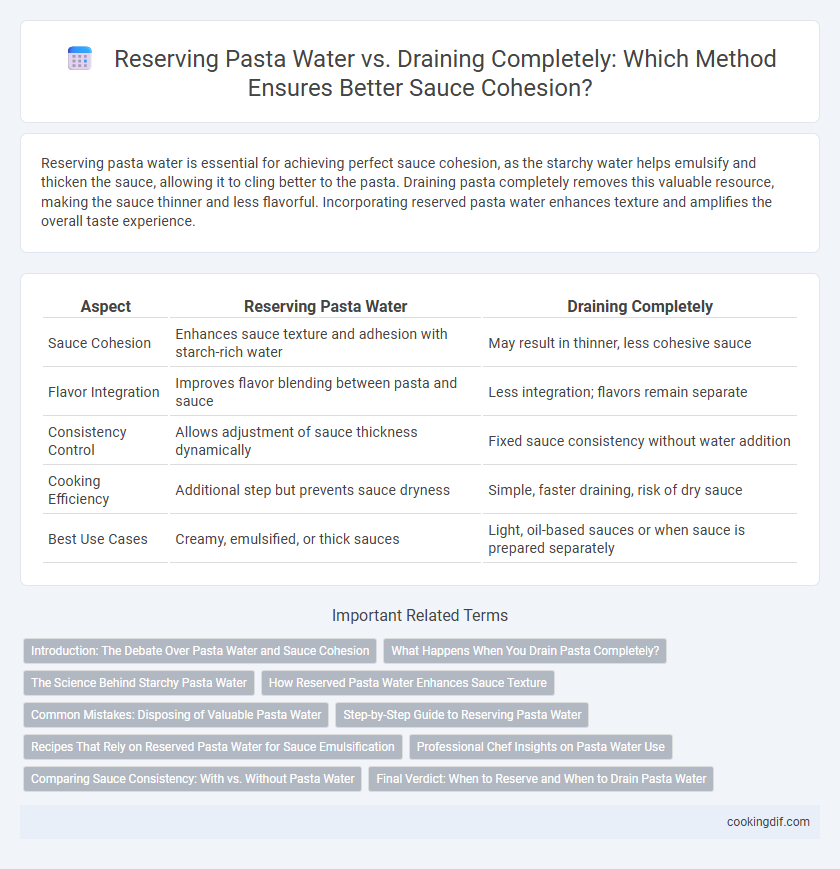Reserving pasta water is essential for achieving perfect sauce cohesion, as the starchy water helps emulsify and thicken the sauce, allowing it to cling better to the pasta. Draining pasta completely removes this valuable resource, making the sauce thinner and less flavorful. Incorporating reserved pasta water enhances texture and amplifies the overall taste experience.
Table of Comparison
| Aspect | Reserving Pasta Water | Draining Completely |
|---|---|---|
| Sauce Cohesion | Enhances sauce texture and adhesion with starch-rich water | May result in thinner, less cohesive sauce |
| Flavor Integration | Improves flavor blending between pasta and sauce | Less integration; flavors remain separate |
| Consistency Control | Allows adjustment of sauce thickness dynamically | Fixed sauce consistency without water addition |
| Cooking Efficiency | Additional step but prevents sauce dryness | Simple, faster draining, risk of dry sauce |
| Best Use Cases | Creamy, emulsified, or thick sauces | Light, oil-based sauces or when sauce is prepared separately |
Introduction: The Debate Over Pasta Water and Sauce Cohesion
Reserving pasta water enhances sauce cohesion by utilizing the starchy liquid to bind ingredients and achieve the perfect silky texture. The starch content in the pasta water acts as a natural emulsifier, improving the sauce's thickness and adhesion to noodles. Completely draining pasta water may result in losing this essential element, potentially leading to a thinner and less cohesive sauce.
What Happens When You Drain Pasta Completely?
Draining pasta completely removes the starchy water that plays a crucial role in sauce cohesion, causing the sauce to be less creamy and unable to adhere properly to the noodles. Without reserved pasta water, the sauce may become too thick or separate, losing its smooth texture and flavor integration. Using reserved pasta water helps to emulsify the sauce, improving consistency and enhancing taste by binding the ingredients together.
The Science Behind Starchy Pasta Water
Starchy pasta water contains soluble starch molecules released during cooking, which emulsify and thicken sauces for better adhesion to pasta strands. Reserving this water enhances sauce cohesion by creating a velvety texture and preventing separation, as the starch acts as a natural binder between sauce and noodles. Draining pasta water completely removes these essential starches, often resulting in thinner, less integrated sauces that fail to cling properly.
How Reserved Pasta Water Enhances Sauce Texture
Reserving pasta water plays a crucial role in enhancing sauce texture by adding starchy, salty liquid that binds ingredients more effectively. The starch in the water acts as a natural thickener, creating a silky, cohesive sauce that clings better to the pasta. Incorporating reserved pasta water instead of draining completely helps achieve a perfect balance of moisture and flavor in the final dish.
Common Mistakes: Disposing of Valuable Pasta Water
Discarding pasta water is a frequent culinary error that overlooks its starch-rich composition essential for sauce cohesion and texture. Reserving and gradually incorporating pasta water enhances emulsification, blending olive oil or butter with sauce ingredients for a velvety finish. Skipping this step leads to dry, separated sauces lacking depth and smoothness in dishes like carbonara or cacio e pepe.
Step-by-Step Guide to Reserving Pasta Water
Reserving pasta water enhances sauce cohesion by utilizing the starchy liquid to bind ingredients and adjust consistency. To reserve pasta water, set aside a cup before draining pasta completely using a colander. Gradually add the saved water to the sauce, stirring until the desired thickness and smooth texture are achieved for a perfectly coated dish.
Recipes That Rely on Reserved Pasta Water for Sauce Emulsification
Recipes that rely on reserved pasta water for sauce emulsification benefit from the starch-rich liquid's ability to bind ingredients and enhance texture. When preparing dishes like cacio e pepe or carbonara, reserving a cup of pasta water allows the sauce to achieve a creamy, cohesive consistency without added cream or fat. Draining pasta completely removes this essential emulsifying agent, resulting in a less integrated sauce and diminished flavor harmony.
Professional Chef Insights on Pasta Water Use
Professional chefs emphasize reserving pasta water for maintaining sauce cohesion, as its starchy content enhances emulsification between sauce and pasta. Draining pasta water entirely risks losing this natural thickening agent, leading to a less integrated, dryer sauce consistency. Incorporating reserved pasta water adjusts sauce viscosity and binds flavors, elevating the overall texture and mouthfeel in culinary preparations.
Comparing Sauce Consistency: With vs. Without Pasta Water
Incorporating reserved pasta water into sauce enhances consistency by adding starchy residue that thickens and binds the sauce more effectively than draining pasta completely. Without pasta water, sauces may appear thinner and less cohesive, lacking the natural emulsification that starchy water provides. This key difference in texture and gloss significantly improves the overall mouthfeel and flavor integration of pasta dishes.
Final Verdict: When to Reserve and When to Drain Pasta Water
Reserving pasta water is essential when making sauces that require emulsification, such as Alfredo or carbonara, as the starchy water enhances sauce adhesion and creaminess. Draining pasta water completely is preferable for dishes with heavier sauces or baked pasta recipes where moisture control is critical to prevent sogginess. The final verdict is to reserve pasta water when the sauce benefits from added starch and moisture, but drain thoroughly when the recipe calls for a drier texture or structural integrity.
Reserving pasta water vs draining completely for sauce cohesion Infographic

 cookingdif.com
cookingdif.com